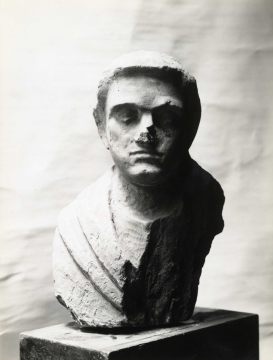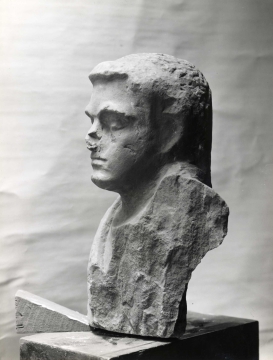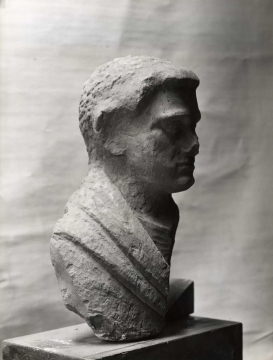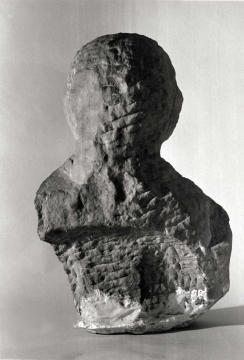Explore Collections


You are here:
CollectionsOnline
/
Bust of a Roman private citizen of the Imperial second century
Browse
Bust of a Roman private citizen of the Imperial second century
2nd century AD
Pentelic marble
Height: 64cm
Museum number: M498
On display: Sepulchral Chamber
All spaces are in No. 13 Lincoln's Inn Fields unless identified as in No. 12, Soane's first house.
For tours https://www.soane.org/your-visit
Curatorial note
This bust of a beardless togate man of early middle age has proved of interest to scholars in spite of the destruction of the surfaces which renders positive analysis difficult and which presents a deceptive cast to the external character of the person portrayed. F. Poulsen suggested a Hadrianic dating based on 'slight remains of drilling of the pupils, the shape of the bust, and the beardlessness of the head'. He concluded 'in spite of destruction, remains are still preserved of the energetic expression of the head, the strong arched brows, and the defiant chin'. Prof. J.D. Craig sought to identify this person as Horace and the bust as the only genuinely faithful representation of the poet, as visualised from fourth century contorniate likenesses. He characterized the portrait as that of 'a little, mild, pensive or melancholy man, with clearly marked eyebrows, a straight nose, and a somewhat dogged chin'. He noticed that a broad hollow behind the ridge of hair on the brow suggested a place where a wreath was held in position.
While valid theories have been built on less evidence than that with which Prof. Craig supports his arguments, the suggested identification as Horace must await at least the equivalent amount of material on which Neugebauer based his naming of the Berlin-Athens-Soane (see Soane M517/Vermeule 410) replicas as Polydeukes of Athens. For the argument that Horace is the figure in front of Vergil and Propertius on one of the Della Valle reliefs built in to the garden façade of the Villa Medici and perhaps from the Ara Pietatis Augustae, see Carpenter.1
This bust is Roman work, probably of the Hadrianic period. Under the Empire and especially during the first century, but carrying on into the second and third, there are similar busts and statues, usually only cursorily finished on their rearward sides, of togate private citizens which were probably set up in household niches or sepulchral monuments - this bust falls into this category. Comparison emphasises the striking similarity of this badly preserved sculpture to the upper half of a standing early Imperial private citizen in the large storage garden of the Naples Museum (at the bottom facing the wall when Vermeule saw it). This fragment shows a similar treatment of face and drapery in broad flesh and fold masses and incised lines which soon disappear outside due to weathering. The unfinished workmanship on the unviewed portions is found in the best-quality Imperial statuary - witness the Augustus from Livia's villa at Prima Porta. Statues of well known Republican and Imperial citizens, Senators and knights clad in the formal toga, were also set up in public and semi-private spaces such as baths, markets, stadia, etc. Although we are acquainted with many of the best examples of this semi-public commemorative art, many of these togati (toga wearers) are of no exceptional merit. Such statues can be seen in public parks from Rome to the excellent but unfortunately weathered togati at Chiswick House in London. A standing statue, with head unbroken, of a togatus (with duck by his left foot) along the main path of the Villa Celimontana (Societa Geografica Italica, better known as theVilla Mattei) gardens in Rome, probably dates to c.50 BC and shows the predecessor type of the Soane bust. Again the back is unfinished and again in spite of heavy weathering the flat, broad, criss-crossed masses of drapery are practically the signature of second rate sculptures of this class. The Soane bust perhaps depicted the right hand grasping the hem of the over-fold at the lower front centre, the point where the heaviest frontal fracture occurs.
For Horace in the Museum of Fine Arts, Boston, votive (?) relief from Italy (accession no. 00.311), Fuhrmann's candidate, see K. Schefold, Bildnisse, p. 178, fig. 1; M.F.A., Greek and Roman Portraits, 1959, fig. 35; Handbook, 1963, fig. 214 (Greek, Etruscan and Roman Art).
1 Carpenter, Mem. Amer. Acad., XVIII, p. 101, pl. 31f.; a less plausible attempt to connect the elusive features of Horace with a relief portrait was made by H. Fuhrmann, in AJA, XL, 1936, pp. 73-91.
While valid theories have been built on less evidence than that with which Prof. Craig supports his arguments, the suggested identification as Horace must await at least the equivalent amount of material on which Neugebauer based his naming of the Berlin-Athens-Soane (see Soane M517/Vermeule 410) replicas as Polydeukes of Athens. For the argument that Horace is the figure in front of Vergil and Propertius on one of the Della Valle reliefs built in to the garden façade of the Villa Medici and perhaps from the Ara Pietatis Augustae, see Carpenter.1
This bust is Roman work, probably of the Hadrianic period. Under the Empire and especially during the first century, but carrying on into the second and third, there are similar busts and statues, usually only cursorily finished on their rearward sides, of togate private citizens which were probably set up in household niches or sepulchral monuments - this bust falls into this category. Comparison emphasises the striking similarity of this badly preserved sculpture to the upper half of a standing early Imperial private citizen in the large storage garden of the Naples Museum (at the bottom facing the wall when Vermeule saw it). This fragment shows a similar treatment of face and drapery in broad flesh and fold masses and incised lines which soon disappear outside due to weathering. The unfinished workmanship on the unviewed portions is found in the best-quality Imperial statuary - witness the Augustus from Livia's villa at Prima Porta. Statues of well known Republican and Imperial citizens, Senators and knights clad in the formal toga, were also set up in public and semi-private spaces such as baths, markets, stadia, etc. Although we are acquainted with many of the best examples of this semi-public commemorative art, many of these togati (toga wearers) are of no exceptional merit. Such statues can be seen in public parks from Rome to the excellent but unfortunately weathered togati at Chiswick House in London. A standing statue, with head unbroken, of a togatus (with duck by his left foot) along the main path of the Villa Celimontana (Societa Geografica Italica, better known as theVilla Mattei) gardens in Rome, probably dates to c.50 BC and shows the predecessor type of the Soane bust. Again the back is unfinished and again in spite of heavy weathering the flat, broad, criss-crossed masses of drapery are practically the signature of second rate sculptures of this class. The Soane bust perhaps depicted the right hand grasping the hem of the over-fold at the lower front centre, the point where the heaviest frontal fracture occurs.
For Horace in the Museum of Fine Arts, Boston, votive (?) relief from Italy (accession no. 00.311), Fuhrmann's candidate, see K. Schefold, Bildnisse, p. 178, fig. 1; M.F.A., Greek and Roman Portraits, 1959, fig. 35; Handbook, 1963, fig. 214 (Greek, Etruscan and Roman Art).
1 Carpenter, Mem. Amer. Acad., XVIII, p. 101, pl. 31f.; a less plausible attempt to connect the elusive features of Horace with a relief portrait was made by H. Fuhrmann, in AJA, XL, 1936, pp. 73-91.
Unrecorded
Literature
J. D. Craig, Proceedings of the Classical Association, XXXII. V.1935, pp.38-41.
F. Poulsen, Greek and Roman Portraits in English Country Houses, trans. G.C.Richards, Oxford, 1923, p. 94, no. 80.
F. Poulsen, Greek and Roman Portraits in English Country Houses, trans. G.C.Richards, Oxford, 1923, p. 94, no. 80.
Soane collections online is being continually updated. If you wish to find out more or if you have any further information about this object please contact us: worksofart@soane.org.uk









